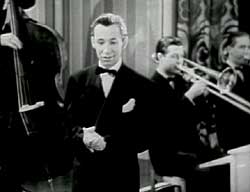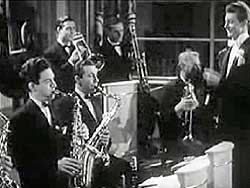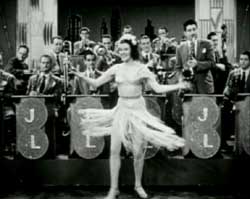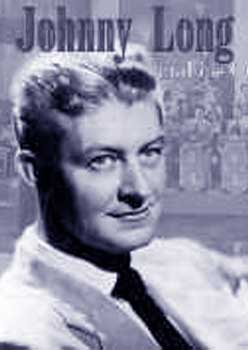 Johnny Long formed his orchestra in 1931 at Duke University as "The Duke Freshmen," soon after renamed the Duke Collegians, taking over duties as college band from the Les Brown Orchestra. Johnny Long formed his orchestra in 1931 at Duke University as "The Duke Freshmen," soon after renamed the Duke Collegians, taking over duties as college band from the Les Brown Orchestra.
Upon graduating the band kept working & became Johnny Long & His Orchestra, & worked steadily under this name beginning in 1935 as a reliable but never especially significant hotel band, though occasionally someone passed through the band who was suburb, such as Joe Williams or Huey Long.
The orchestra performs the title number of the Phonoview soundie Boogie Man (1943). It appears that all Johnny's 1943 soundies were actually filmed in 1941 for Phonoview but never released until purchased by Mills Panoram.
With banal lyrics like "The boogie man will get you if you don't watch out" there's not a lot to be said for what Johnny is singing. And the whole idea that the man who performs boogie-woogie being a threat to children has a racist origin. Of course, in the complete lyric, it's a good thing to finally be gotten by the boogie man & no longer be a square.
It's not badly played instrumentally, & Paul Harmon's vocal has a bit of hick twang to his style that he can't escape even in sophisticated dinner clothes. The best part is the instrumental break which is pretty decent basic swing boogie.
 Johnny Long & His Orchestra are so upscale preppy it hardly seems apropos that they're performing In a Shanty in Old Shanty Town (1943), updating it a bit with some new lyrics.
Johnny Long & His Orchestra are so upscale preppy it hardly seems apropos that they're performing In a Shanty in Old Shanty Town (1943), updating it a bit with some new lyrics.
This was a so-so hit for Johnny's band, who recorded it twice, even though the subject matter in no way suits their image or their sound.
Johnny conducts in his tux & tails then the band stands up & begins singing the number. "It's only a shanty in old shanty town/ It's roof is slanty, it touches the ground/ But my tumbled down shack by the railroad track/ Like a millionare's mansion keeps calling me back."
On record labels for songs on which the band members sang, they are credited as being "The Glee Club," but there was no such separate group of singers.
The song had fast become a standard after it was published in 1936, composed by Ira Schuster & Jack Little, with lyrics by Joe Young. Joe also co-wrote the lyrics for "Annie Doesn't Live Here Any More." Jack Little was also known as Little Jack Little, a fantastic pianist who had his own popular orchestra in the 1930s.
Although it's a marvelous song, as performed by this row of guys in the Johnny Long orchestra, it's best described as cute but not so good when the jazz arrangement is this tame. Johnny's was called a "society band" which for later decades would be the equivalent of preppy, yuppy, collegiate, middle class, or by my tastes milquetoast.
Johnny Long's big band sound plus a chorus of glee club vocalists became the signature of the Johnny Long orchestra. And though forgotten now, Johnny's band with its lowkey sound was surprisingly pupular during the war years, even though greater fame never found him.
He made more soundies (eighteen) than any other single act, most no worse or better than this one. The ones made in 1943 were done by Phonovision, a pioneering company for sound films who had specialized in just such films since before there were panorams jukeboxes.
 Johnny & his orchestra appear with guest dancer Doris York, covering a Glenn Miller hit from a couple years before, It Must Be Jelly ('Cause Jam Don't Shake Like That) (1946).
Johnny & his orchestra appear with guest dancer Doris York, covering a Glenn Miller hit from a couple years before, It Must Be Jelly ('Cause Jam Don't Shake Like That) (1946).
"Jelly" was a sexual reference among jazz & blues men, so Doris is being dissed. It's not as funny as intended, but the boogie number is pretty fun even so.
The trombone player stands to sing, "It must be jelly cuz jam don't shake like that/ Yeah it must be jelly cuz jam don't shake like that/ But baby, you're a real hip cat."
Through sax solo & the whole number, Doris never slows down. Johnny Long made quite a few soundies -- more than any other working name band -- & most of them are rather dull. Doris makes this one visually enticing, which can make a band's workmanlike efforts seem lots of fun.
copyright © by Paghat the Ratgirl
|



